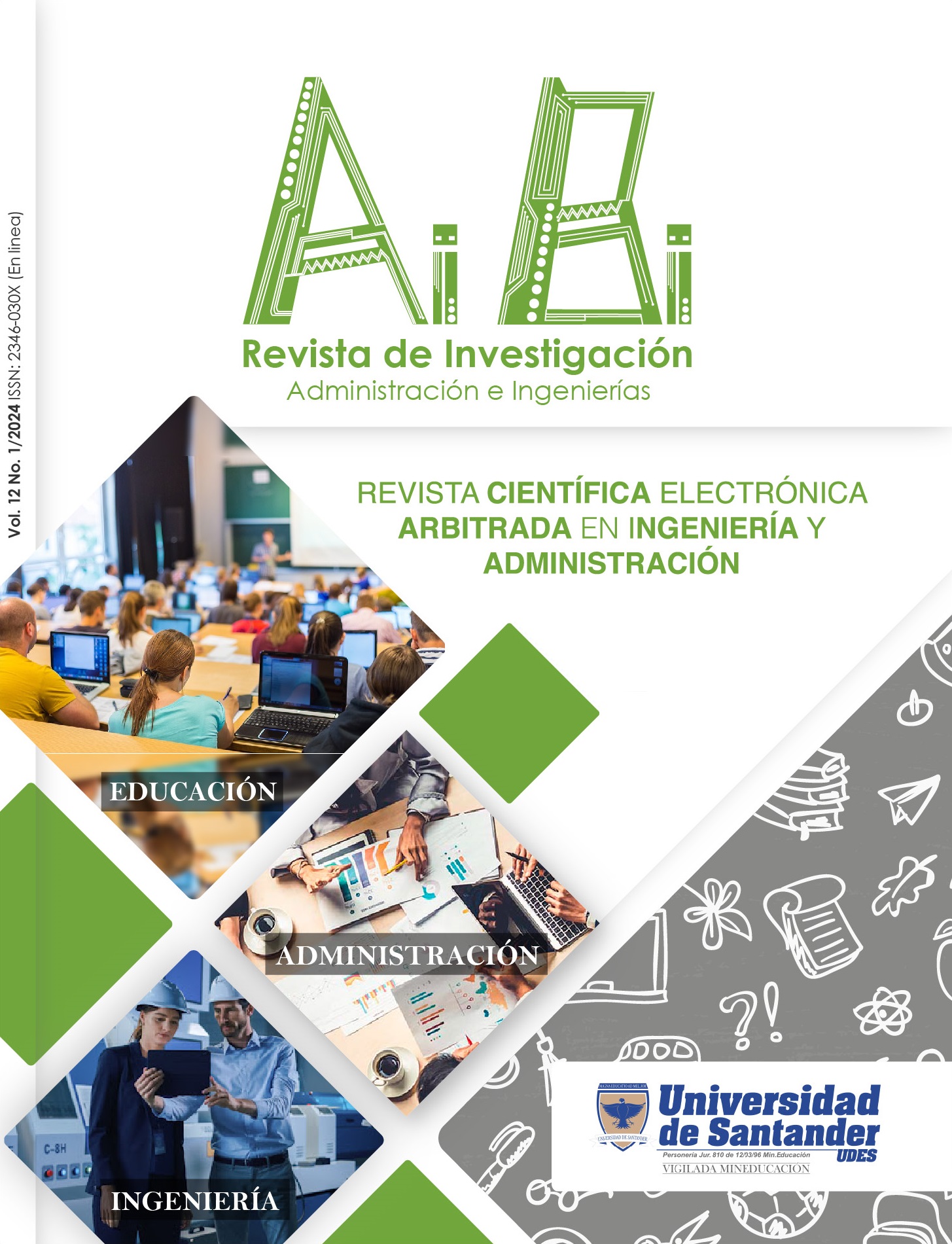Comprehensive deformation study in the new Austrian tunneling technique tunnel utilising artificial neural network model
DOI:
https://doi.org/10.15649/2346030X.3631Palabras clave:
new austrian tunnelling technique, root mean squared error, artificial neural network, tunnel, mean absolute percentage errorResumen
Ground deformation during tunneling projects is one of the complicated concerns that must be constantly monitored to prevent unanticipated damages and human losses. In addition to conventional approaches, several intelligent methods, like ANN, have recently been used for different tunnel challenges. Geological elements such as thrust zones, folded rock sequences, shear zones, rock cover, in-situ tensions, water ingress, gas ingress, geothermal gradient, and significant seismicity all present difficulties during digging. These difficulties have a substantial influence on the routine functioning of the tunnel as well as traffic safety. To address these issues, the authors recommended using ANNs from many elements of tunnel engineering. The new Austrian tunneling technique (NATM) has shown to be a highly affordable and versatile mode of construction, and as a result, it has become the most common tunneling construction method utilized in the building of the double-arched tunnel. In this work, the MATLAB program was utilized to generate the results, which comprised training and testing datasets. The experimental results demonstrate that the suggested model's values for R2, Bias, Mean Absolute Percentage Error (MAPE) and Root Mean Squared Error (RMSE), with training data are 18.56, 0.98, 1.05, and 0.08, respectively. The suggested RMSE, R2, Bias, and MAPE values for the test dataset were 19.89, 0.98, 1.05, and 0.09.
Referencias
G. Barla and S. Pelizza, “TBM tunneling in difficult ground conditions” in Engineering Geology, Proc. International Conference on Geotechnical & Geological Engineering, Melbourne, Australia. Technomic, 2000, pp. 329-354.
S. Mahdevari et al., “Application of artificial intelligence algorithms in predicting tunnel convergence to avoid TBM jamming phenomenon,” Int. J. Rock Mech. Min. Sci., vol. 55, pp. 33-44, 2012.
J. Lai et al., “Prediction of soil deformation in tunneling using artificial neural networks,” Comp. Intell. Neurosci., vol. 2016, pp. 6708183, 2016. doi:10.1155/2016/6708183.
Q. Yan et al., “Field monitoring of deformations and internal forces of surrounding rocks and lining structures in the construction of the Gangkou double-arched tunnel—A case study,” Appl. Sci., vol. 7, no. 2, p. 169, 2017. doi:10.3390/app7020169.
Aydin et al., “Geomechanical characterization, 3-D optical monitoring and numerical modeling in Kirkgecit-1 tunnel, Turkey,” Eng. Geol., vol. 181, pp. 38-47, 2014. doi:10.1016/j.enggeo.2014.08.010.
D. Lefas et al., “Monitoring of tunnel behavior through cataclastic rocks,” Geotech. Eng., vol. 159, pp. 113-123, 2006.
F. Ariznavarreta-Fernández et al., “Measurement system with angular encoders for continuous monitoring of tunnel convergence,” Space Technol., vol. 56, pp. 176-185, 2016. doi:10.1016/j.tust.2016.03.014.
Y. Zhang et al., “Stability analysis of shotcrete supported crown of NATM tunnels with discontinuity layout optimization,” Int. J. Numer. Anal. Meth. Geomech., vol. 42, no. 11, pp. 1199-1216, 2018. doi:10.1002/nag.2775.
Https://theconstructor.org/geotechnical/new-austrian-tunneling-method/63500/.
HSE (Health and Safety Executive), ‘Safety of New Austrian Tunnelling Method (NATM) tunnels: A review of sprayed concrete lined tunnels with particular reference to London clay,’ Tech [Rep.], 1996 (reissued as PDF in, 2014).
K. Haruyama et al., “Construction of large cross-section doubletier Metropolitan Intercity Highway (Ken-O-Do) Ome Tunnel by NATM,” Tunnelling Undergr. Space Technol., vol. 20, no. 2, pp. 111-119, 2005. doi:10.1016/j.tust.2003.08.007.
M. Rezaei and M. Rajabi, “Vertical displacement estimation in roof and floor of an underground powerhouse cavern,” Eng. Fail. Anal., vol. 90, pp. 290-309, Aug. 2018. doi:10.1016/j.engfailanal.2018.03.010.
X. Wang et al., “Application of artificial neural network in tunnel engineering: A systematic review,” IEEE Access, vol. 8, pp. 119527-119543, 2020. doi:10.1109/ACCESS.2020.3004995.
Maidl et al., “Handbook of tunneling engineering,” vol. I, Structures and Methods. Berlin: Ernst and Sohn, 2013.
L. C. Vydrova, Comparison of Tunneling Methods NATM and Adeco RS, 2015.
R. A. Abdullah, “A review on a selection of tunneling method and parameters affecting ground settlements,” Electron. J. Geotech. Eng., vol. 21, no. 14, pp. 4459-4475, 2016.
R. A. Arshad and A. Abdullah, “Review on selection of tunnelling method and parameters affecting ground settlement,” Mal. Eng. vo, vol. 21 Bund 14, 2016.
w. Schubert, Development and Background of NATM, Austrian Tunnelling Seminar Ankara, Austrian Society for Geomechanics, March 31st & April 1st 2015.
L. Singh et al., Necessity of NATM Tunnel in Himalayas-A Case Study of Rohtang Tunnel, 2017, pp. 483-489.
R. Ade Khoir and A. Dewanti Putri, “The effectiveness of new Austrian tunneling method (NATM) for hydropower plant construction: Lau gunung power plant, north Sumatera, Indonesia” in MATEC Web Conf. EDP Sciences, vol. 138, p. 04012, 2017. doi:10.1051/matecconf/201713804012.
S. S. Barbole and R. D. Pawar.” Review on Tunnel Construction by New Austrian Tunneling Method.” International Research Journal of Engineering and Technology (IRJET). Available at: https://www.irjet.net/archives/V8/i1/IRJET-V8I1358.pdf, p. n0.8(2021): 2134-2137.
V. Phadke and N. Titirmare, “Construction of tunnels, by new Austrian tunneling method (NATM) and by tunnel boring machine (TBM),” Int. J. Civ. Eng. (IJCE), vol. 6, no. 6, pp. 25-36, 2017. doi:10.22214/ijraset.2021.36463. Available at: http://www.ijraset.com.
Ahmad et al., “New Austrian tunneling method (NATM) in Himalayan Geology: Emphasis on execution cycle methodology,” Int. J. Eng. Res. Technol., vol. 8, pp. 39-52, 2019.
Z. Hongfei et al., “Research on forward simulation of tunnel lining cavity GPR images,” Rock Soil Mech., vol. 30, no. 09, pp. 2810-2814 + 2842, 2009.
M. L. Guo and S. P. Huang, “The research of detection and treatment of tunnel lining cavity” in MATEC Web Conf. EDP Sciences, vol. 44, p. 02079, 2016. doi:10.1051/matecconf/20164402079.
X. Guangzhi, “Discussion on design and construction improvement measures based on current typical diseases of railway tunnel lining,” Tunnel Constr., vol. 38, no. 09, pp. 1416-1422, 2018.
L. Yanpeng et al., “Study on the method of reinforcing with compound cover arch in existing cracked tunnels,” Highway, vol. 63, no. 09, pp. 289-295, 2018.
Available at: https://patents.google.com/patent/CN102182472A/en, Google.
P. An et al., “Forecast of ground deformation caused by tunnel excavation based on intelligent neural network model,” Mob. Inf. Syst., vol. 2022, 1-12, 2022. doi:10.1155/2022/2924093.
Ngamkhanong et al., “Data-driven prediction of stability of rock tunnel heading: An application of machine learning models,” Infrastructures, vol. 7, no. 11, p. 148, 2022. doi:10.3390/infrastructures7110148.
An, Puzhen, Baoxin Jia, Fanli Meng, Zhixin Wang, Hailiang Wei, and Yinghui Zhang. "Forecast of Ground Deformation Caused by Tunnel Excavation Based on Intelligent Neural Network Model." Mobile Information Systems 2022 (2022).
H. Huo et al., “A method for predicting seismic stress and deformation of circular tunnels based on BP artificial neural network” in Challenges and Innovations in Geomechanics, Proc. 16th International Conference of IACMAG-Volume 2, vol. 16. Springer International Publishing, 2021, pp. 369-376.
N. Zhang et al., “Measurement and prediction of tunneling-induced ground settlement in karst region by using expanding deep learning method,” Measurement, vol. 183, p. 109700, 2021. doi:10.1016/j.measurement.2021.109700.
S. Nsubuga et al., “A smart decision tool for the prediction of tunnel crown displacements,” Appl. Geom., vol. 13, pp. 77-91, 2021.
R. Wu et al., “Integrating domain knowledge with deep learning models: An interpretable AI system for automatic work progress identification of NATM tunnels,” Tunnelling Undergr. Space Technol., vol. 105, p. 103558, 2020. doi:10.1016/j.tust.2020.103558.
G. C. Balta and I. Koseoglu, “Dikmen, and M. T. Birgonul”. "Bayesian network-based decision support for predicting and mitigating delay risk in TBM tunnel projects.", Autom. Constr., vol. 129, p. 103819, 2021.
Mousivand, Mohsen, Mohammad Maleki, Masood Nekooei, and Mohammad Reza Mansoori. "Cross Section Effects on Convergence-Confinement Method in Multistage Tunnel Excavation." Journal of Rehabilitation in Civil Engineering 7, no. 1 (2019): 35-48
V. Aakash and B. Ashutosh, “Excavation method implemented in Atal (Rohtang) tunnel: Case study,” Int. J. Res. Appl. Sci. Eng. Technol. (IJRASET), pp. 1065-1068, 2021.
L. M. Singh et al., “Ground response and support measures for Rohtang tunnel in the Himalayas” in Sustainable Tunneling and Underground Use, Proc. 2nd GeoMEast International Congress and Exhibition on Sustainable Civil Infrastructures, EgyptThe Official International Congress of the Soil-Structure Interaction Group in Egypt (SSIGE). Springer International Publishing, 2019, pp. 105-125. doi:10.1007/978-3-030-01884-9_9.
K. K. Sharma, “Study of roof collapse in Rohtang tunnel during construction,” J. Rock Mech. Tunnelling Technol. (JRMTT), vol. 22, no. 1, pp. 11-20, 2016.
Available at: https://theconstructor.org/case-study/atal-rohtang-tunnel-construction-of-the-worlds-longest-highway-tunnel/95419/.
M. Zaid and I. A. Shah, “Numerical analysis of Himalayan rock tunnels under static and blast loading,” Geotech. Geol. Eng., vol. 39, no. 7, pp. 5063-5083, 2021. doi:10.1007/s10706-021-01813-z.
T. Singh et al., “Physico-mechanical behavior of metamorphic rocks in Rohtang Tunnel, Himachal Pradesh, India,” Procedia Eng., vol. 191, pp. 419-425, 2017. doi:10.1016/j.proeng.2017.05.199.
N. K. Trivedi et al., “An efficient credit card fraud detection model based on machine learning methods,” Int. J. Adv. Sci. Technol., vol. 29, no. 5, pp. 3414-3424, 2020.
J. A. Darsey et al., “Architecture and biological applications of artificial neural networks: A tuberculosis perspective” in, Methods Mol. Biol. New York, NY: Springer, vol. 1260, (pp. 269-283), 2015. doi:10.1007/978-1-4939-2239-0_17.
O. Kisi et al., “Modeling rainfall-runoff process using soft computing techniques,” Comput. Geosci., vol. 51, pp. 108-117, 2013. doi:10.1016/j.cageo.2012.07.001.
N. J. D. Nagelkerke, “A note on a general definition of the coefficient of determination,” Biometrika, vol. 78, no. 3, pp. 691-692, 1991. doi:10.1093/biomet/78.3.691.
S. Prasomphan and S. Mase, “Generating prediction map for geostatistical data based on an adaptive neural network using only nearest neighbors,” Int. J. Mach. Learn. Comput., vol. 3, no. 1, pp. 98-102, 2013. doi:10.7763/IJMLC.2013.V3.280.
J. S. Armstrong and F. Collopy, “Error measures for generalizing about forecasting methods: Empirical comparisons,” Int. J. Forecast, vol. 8, pp. 69-80, 1992. doi:10.1016/0169-2070(92)90008-W.
Descargas
Publicado
Cómo citar
Descargas
Número
Sección
Licencia
Derechos de autor 2024 AiBi Revista de Investigación, Administración e Ingeniería

Esta obra está bajo una licencia internacional Creative Commons Atribución 4.0.
La revista ofrece acceso abierto bajo una Licencia Creative Commons Attibution License

Esta obra está bajo una licencia Creative Commons Attribution (CC BY 4.0).










